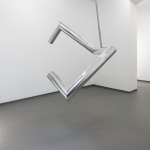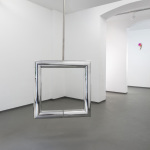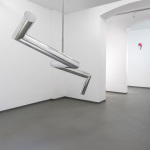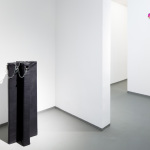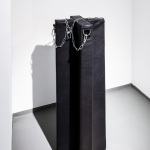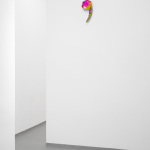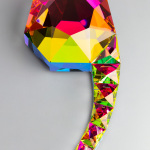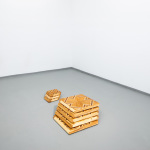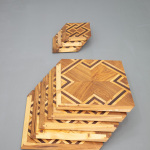Via Lewandowsky
GEOMETRY OF OBEDIENCE
28.03 - 04.05.2019
Curated by Jungmin Lee
1-3 A Square Meter, 2019, aluminum, electric motors, 100 x 100 cm
4-5 Newtonmeter per Squaremeter, 2019, metal chain, leather, 130 x 50 x 50 cm
6, 7 Splendor of Omission, 2019, cutted glass, 40 x 20 cm
8, 9 Madonna Kneeling With Child, 2019, parquet floor from a late 19th-century villa in Berlin,
17 x 80 x 80 cm / 10 x 40 x 40 cm
Photo Thomas Bruns
*scroll down for German Version
ON VIA LEWANDOWSKY
ART · FORM · DIALECTIC · SQUARE · GEOMETRY · SUBJECT · BREAKAGE · DESTABILISATION · RESISTANCE · POETIC DECONSTRUCTION
Marcus Steinweg
trans. Beatrix Joyce
Art. - The fact that Art represents an extension beyond itself, as Jean-Luc Nancy writes, means that it is still in the process of transcendence, excess, and the submersion of itself. Neither does it enclose itself in the fantasy of pure selfhood, nor does it legitimize itself in political action. It turns the resistance to the temptations of l'art-pour-l 'art and well-meant self-instrumentalization into Art. It is neither useful nor useless, but rather both in one, with the same intensity. Art does not only touch its exterior: it has long been inhabited by it and can no longer distinguish itself from it, like Hegel's cows that blur with darkness. In its resistance to its environment, it testifies its dependency and resistance. It keeps itself in the midst of a dialectic of freedom and bondage by not coming to rest on either side. Its extension beyond itself expresses a dynamic that does not come to a standstill. Its a prioritise of transcendence, which is neither religious nor theological, marks its outsideness. It denies the facts as it drills holes into them to destabilize them with doubt. This tension, this trembling, and sliding, whose precision is manifested in significant works of Art, constitutes the artwork. These artworks oscillate between familiarity and unfamiliarity, old and new, evidence, and non-evidence. Translated into the vocabulary of German idealism, they express the conflict between identity and difference, finiteness, and infinity. Instead of bowing to the imperatives of the functional or the purposeless, the artwork marks the scene of an insoluble conflict.
Form.- Art is an assertion of form even when it calls into question the authoritarianism of form or begins to satirize it. Perhaps every artistic assertion of form is accompanied by a touch of irony. Undoubtedly, it does not take away from its rigidity. However, it does take away from its rigidity, insofar as Art involves the humorous acceptance of certain futility. Convincing Art consists, in part, of the experience of futility. It is not exhausted in pathetic self-doubt. Instead, it plays with futility and integrates it into the artwork as an essential part of it, without neutralizing it. In the form search, the ex-negativo affirmation of factual formlessness is expressed. Even the most successful form refers to its opposite. It indicates that it remains in the index of formlessness or chaos, with certain incommensurability. In Theodor W. Adorno's text on the visual world of the Freischütz, the word "Formimmanenz" (immanence of form) appears. Adorno clarifies that Carl Maria von Weber's opera is not closed, but is rather open to the outside and breathing. There is room for the indefinite: "Through windows and gaps air flows in..." Adorno speaks of extraterritoriality. He aims at the characteristics of the open work of Art, as Umberto Eco did at the same time, in 1962. Art opens itself to that which lies outside of Art: society, history, political calculation, symbolic dictates, cultural language, the world. In as much as every artistic practice raises the question of form, it must be content with an openness of form that implies the permeability of the artwork to its conditions.
Dialectic. - No immanence without transcendence! This is the imperative formulated by Adorno's Ästhetische Theorie (1970). It is not meant as a return to religious atavisms or as theology, esotericism, or animism. But rather as an insistence that transcendental immanence remains a religious phantasm, through which the belief in the closed-form proves to be metaphysical. The immanence of the form must integrate its permeability to the formless into its self-understanding in order not to be an illusory totality. This applies to music, poetry, painting, sculpture, installation, performance, dance, and thought. The feat of artistic production is to respond to formlessness with form. The transcendence within immanence prevents its closure. It denies the possibility of a successful totality. By doing so, it opens the form to its opposite in order to set in motion a dialectic that does not come to rest. Adorno calls it a negative dialectic: its function lies in the postponement of a final synthesis. It is a dialectic with an open outcome. As such, it demands precision and the will of form. Hegel speaks of the work of the concept.
Square.- Via Lewandowsky opens the square to itself as if he intended to break the imperiality of geometry and its totalism. With humor, or with irony? Undoubtedly. But also with artistic determination and rigidity. There is such a thing as the precision of the joke. Lewandowsky's work is an example of such precision. The totality, i.e., the wholeness and unity of the square, which is the epitome of pure form, is broken up by breaking it open, setting it in motion, vitalizing it, moving from the Platonic heaven of ideas into the immanence of the real world, including its imperfections. The ideology-critical and political implications of such a gesture are obvious. The point is to break with the totalism of form, which correlates with political purity and the illusion of unbreakability.
Geometry. - Perhaps in Lewandowsky's case, one can speak of geometries of imperfection; geometries of uncertainty and indeterminacy. They, too, are concerned with opening up to the outside, which eludes mathematical control. Here, too, the point is to open the window to chaos in order to confront the always dictatorial purism of form with everything that escapes its self-understanding. The realness of form is in the formlessness it conceals. The dialectic between form and formlessness does not come to a standstill. It is a dialectic in actu: a negative dialectic that does not allow itself the triumph of a final synthesis. This does not mean that it throws itself into formlessness. It seeks a form for the formless. With humor and wit, but also with rigidity and poetry, it detects the limits of total closure. The assertion of the possibility and necessity of such closure is politically reactionary.
Subject. - Doesn't Lewandowsky's extraction, made for the artistic assertion of form, apply to the (human) subject in general? Instead of asserting itself as a closed entity, it must assert itself as an operator of formlessness. Isn't that what Nietzsche says? It ought to be clear that since Nietzsche, the loss of God - which with Lewandowsky is the loss of the square (at least in terms of metaphysical value) - cannot be saved by its resurrection under a new name. By replacing one inconsistency with another in the name of supposed consistency, one prevents oneself from knowing what one has long known. Nietzsche calls it "Götzendienst" (idolatry). Why not impose on the subject what seems hardly acceptable to it: that God is dead means that all that takes his place is with him. Only in the desert of the non-existence of God and his substitutes does the subject come to itself. Not as a substance secured by identity, but as an agent of aporetic self-mediation with its inconsistent parts, or as Alain Badiou says: "It is not about working on compensating for the loss. It is a matter of accustoming the entire human race to the fact that their own creative constitution lies in the element of this loss."
Breakage. - Instead of assimilating the dominant ideas and established aesthetics, Art would be a break with reality in favor of a reality that cannot yet be classified as real. To break with it in the midst of reality is what one can call "Kunstdenken" (art thinking), instead of success-oriented cultural production. As Mehdi Belhaj Kacem states: "do away, in Rimbaud-style, with everything that is commonly called culture". Do away with the stupidity that sells itself as reality, while it is the established aesthetic, social, political, economic, etc. mechanisms that deprive it of its transformation. To do away with reality is to do away with the opportunistic idealisms that misunderstand themselves as realism, even if they call themselves left-wing. No art counts that do not put an end to the imperiality of active non-thinking that sells itself as realism, while it does nothing but vary the established patterns in favor of their stereotypical cementation in order to produce a good conscience instead of a critical sense of reality. Heiner Müller rightly writes: "categories, wrong or right, miss the work of art." Art doesn't care about categories that dictate its ideology - it tests their validity. Art is what resists the temptation of self-neutralization in the arena of sociopolitical dictates. In the grid of established realities, Art emerges as a breakage. If it does not, it is culture and politics. In the worst case: cultural policy = administration of the existing under the premise of its lack of alternatives. All this as legitimization for what is in fact, a lack of ideas.
Destabilization. - Artistic as well as a philosophical practice, involves bringing together what is held apart. It is always about collaging reality anew. To do this, it has to stir it up, dissolve encrustations and destabilize holdings. Only in this way are new connections, a different picture of reality, and a changed reality possible. Therefore, being open to the unknown is a part of every experimental way of thinking. This has nothing to do with utopianism. Utopianism knows its goal. Experimental thinking does not know where it is going. What it knows is that it wants to go somewhere else (Kafka: "Always away from here, that's the only way I can reach my goal.") It refuses to remain static in the familiar. That makes it an anti-conservational practice. "The artist's strength is a renewal," wrote Deleuze. Art aims at change because what exists calls for its stabilization, that is, for the dogma of the present. But artistic thinking means drilling holes in the dogmas and demonstrating their hollowness and authority. The new resist the existing by pointing to what it represses: it points to other ways of being and ways of life, to undreamt-of possibilities of social and political organization.
Resistance. - Adorno's aesthetic theory conceptualizes the artwork as the setting for the controversial mediation of society and Art or immanence and transcendence. Art can only go beyond itself by going into itself. Within itself, it encounters "its latent social content." To "go into oneself in order to go beyond oneself" is or should be what Art does. This can mean, firstly, to encounter an implicit transcendence within immanence and secondly, to feel the original impact of the social exterior in the pure, supposedly untouched interior, which marks an intrinsic transcendence and an interiority detached from the world. The difference between immanence and transcendence can still be reflected in the difference between nature and culture and in the tension between the beauty of nature and the beauty of Art. Whoever begins to release this tension in favor of one of its poles betrays both since they are only what they are due to this tension. Enlightened thinking begins with the refusal to avoid the irreducible conflict between nature and culture, between the first and the second. First nature and second nature are in themselves illusionary. To substitute the phantasm of abrupt nature with the ideology of consistent culture can only be an expression of denied thinking. In a 1968 text, Adorno addressed this refusal under the name of a second naiveté: "Nowadays there is a kind of the second naiveté among artists. There is not only the first and unjustly highly acclaimed naturalness but also a second that suggests to the artist that the reified, commodified enterprise in which he is clamped is God-given and is an absoluteness. It is the naiveté of those who, without thinking much, conform to the commandments of the cultural industry." Transcendence can be synonymous with resistance. Instead of bowing to the structure of immanence, which is the established reality, the universe of facts, and the operation of facts, Art implicates a resistance to what is given in order to call upon the unthinkable.
Poetic deconstruction. - Lewandowsky criticizes the "rigidity of form" and rejects the "aesthetics of obedience". This does not mean that his work is not conscious of form. On the contrary, it is about questioning the concept of form with the device of form. It is about artistic deconstruction. Analogous to Adorno's intentions, as far as philosophy is concerned with problematizing the concept with the means of conceptual thought, Lewandowsky deconstructs form in the medium of form. The dictatorship of the rigor of form, its adherent purism, and the idealization of a certain abstraction necessarily lead to the ignorance of all that escapes such notions: the concrete that does not bow to the general, life that resists death, and plurality that does not bow to singularity. Herein lies the playful, humorous, and poetic trait of Lewandowsky's work: in the confrontation with the imperatives of seriousness that still dominate contemporary aesthetics.
FÜR VIA LEWANDOWSKY
KUNST · FORM · DIALEKTIK · QUADRAT · GEOMETRIE · SUBJEKT · BRUCH · DESTABILISIERUNG · RESISTENZ · POETISCHE DEKONSTRUKTION
Marcus Steinweg
Kunst.–Dass die Kunst ein Übersichhinausstürzen darstellt, wie Jean-Luc Nancy schreibt, heißt, dass sie, noch im Sichinsichversenken, Transzendenz ist, Exzess und Überstieg. Weder schließt sie sich ins Fantasma reiner Selbstheit ein, noch legitimiert sie sich in politischem Aktionismus. Zur Kunst macht sie der Widerstand gegenüber den Versuchungen des L'art-pour-l'art und der gutgemeinten Selbstinstrumentalisierung. Sie ist weder nützlich noch unnütz, oder, sie ist beides in einem, mit gleicher Intensität. Kunst rührt nicht nur an ihr Außen, sie ist längst von ihm bewohnt, ohne dass sie sich nicht mehr von ihm unterschiede, wie Hegels Kühe, die mit der Dunkelheit verschwimmen. Im Widerstand gegenüber ihrem Milieu bezeugt sie ihre Dependenz wie Resistenz. Sie hält sich inmitten einer Dialektik von Freiheit und Unfreiheit, indem sie auf keiner ihrer Seiten zur Ruhe kommt. Das Übersichhinausstürzen drückt eine Dynamik aus, die nicht zum Stillstand kommt. Der Apriorismus der Transzendenz, die weder religiös noch theologisch ausfällt, markiert ihr Draußensein. Sie ist bei den Tatsachen, die sie verneinen, während sie Löcher in sie bohrt, um sie durch Zweifel zu destabilisieren. Diese Spannung macht sie aus, dieses Zittern und Gleiten, deren Präzision bedeutende Kunstwerke manifestieren. Sie oszillieren zwischen Vertrautheit und Unvertrautheit, Altem und Neuem, Evidenz und Nichtevidenz. Ins Vokabular des Deutschen Idealismus übersetzt tragen sie den Konflikt von Identität und Differenz, Endlichkeit und Unendlichkeit, aus. Statt sich den Imperativen des Zweckhaften oder Zwecklosen zu beugen, markiert das Kunstwerk die Szene eines unlösbaren Konflikts.
Form.–Kunst ist Formbehauptung noch dann, wenn sie den Autoritarismus der Form in Zweifel zieht oder zu persiflieren beginnt. Vielleicht gehört zu jeder künstlerischen Formbehauptung ein ironisches Moment. Zweifellos nimmt es ihr nicht die Strenge, doch es nimmt der Strenge die Strenge, insofern zut Kunst die humorvolle Akzeptanz einer gewissen Vergeblichkeit gehört. Die Erfahrung der Vergeblichkeit ist überzeugender Kunst konstitutib. Sie erschöpft sich nicht in pathetischen Selbstzweifel. Esher geht es darum, mit der Vergeblichkeit zu spielen, sie ins Kunstwerk als für es wesentlich zu integrieren, ohne sie dadurch zu neutralisieren. In der Bemühung um Form dückt sich die Ex-negativo-Bejahung faktischer Formlosigkeit aus. Noch die gelungeste Form verweist auf ihr Gegenteil. Sie indiziert, wessen Index sie bleibt: die Formlosigkeit oder das Chaos, eine gewisse Inkommensurabilität. In Theodor W. Adornos Text zur Bilderwelt des Freischütztaucht das Wort „Formimmanenz“ auf. Adorno verdeutlicht, dass Carl Maria von Webers Oper nicht geschlossen sei. Sie ist offen aufs Außen und atmet. Da ist Raum fürs Unbestimmte: „Durch Fenster und Lücken strömt eine Luft herein...“ Adorno spricht von Exterritorialität. Er zielt aufs Charakteristikum des offenen Kunstwerks, wie es zeitgleich, 1962, Umberto Eco tut. Kunst ist, was sich aufs Kunstaußen öffnet, auf die Gesellschaft, die Geschichte, das politische Kalkül, die symbolischen Diktate, das kulturelle Sprachspiel, die Welt. So sehr jede künstlerische Praxis die Formfrage aufwirft, so sehr muss sie sich mit einer offenen Form begnügen, die die Durchlässigkeit des Kunstwerks auf seine Bedingungen impliziert.
Dialektik.– Keine Immanenz ohne Transzendenz! Das ist der Imperativ, den AdornosÄsthetische Theorie (1970) formuliert. Nicht als Rückkehr zu religiösen Atavismen. Nicht als Theologie, Esoterik, Animismus. Sondern als Insistenz darauf, dass transzendenzlose Immanenz religiöses Fantasma bleibt, durch das sich der Glaube an die geschlossene Form als Metaphysik erweist. Die Formimmanenz muss ihre Durchlässigkeit aufs Formlose in ihr Selbstverständnis integrieren, um nicht illusorischer Totalismus zu sein. Das gilt für Musik, Dichtung, Malerei, Skulptur, Installation, Performance, Tanz und Denken. Der Formlosigkeit mit Form zu antworten – ist Leistung künstlerischer Produktion. Die Transzendenz in der Immanenz verhindert deren Schließung. Sie dementiert die Möglichkeit gelingender Totalität. Indem sie es tut, öffnet sie die Form ihrem Gegenteil, um eine Dialektik in Gang zu setzen, die nicht zur Ruhe kommt. Adorno nennt sie negative Dialektik, ihre Funktion liegt im Aufschub finaler Synthesis. Sie ist Dialektik mit offenem Ausgang. Als solche fordert sie Präzision und Formwillen. Hegel spricht von der Arbeit des Begriffs.
Quadrat.–Via Lewandowsky öffnet das Quadrat gegen es selbst. Als ginge es ihm darum, die Imperialität der Geometrie, ihren Totalismus zu brechen. Mit Humor, mit Ironie? Zweifellos. Aber eben auch mit künstlerischer Entschiedenheit und Strenge. Es gibt so etwas wie die Präzision des Witzes. Lewandowskys Arbeit ist Beispiel solcher Präzision. Die Totalität, d.h. die Ganzheit und Geschlossenheit, des Quadrats, das Inbegriff reiner Form ist, wird gebrochen, indem es aufgebrochen, in Bewegung versetzt, vitalisiert, vom platonischen Ideenhimmel in die Immanenz des Weltwirklichen, samt seiner Imperfektion, eingerückt wird. Die ideologiekritischen und politischen Implikationen einer solchen Geste liegen auf der Hand. Es geht um den Bruch mit dem Totalismus der Form, dem politisch Reinheits und Bruchlosigkeitsphantasmen korellieren.
Geometrie.– Vielleicht kann man in Lewandowskys Fall von Geometrien der Imperfektion sprechen, Geometrien der Unschärfe und Unbestimmtheit. Auch ihnen geht es um die Öffnung aufs Außen, das sich seiner mathematischen Kontrollierbarkeit entzieht. Auch hier geht es darum, das Fenster zum Chaos zu öffnen, um den immer diktatorischen Formpurismus mit all dem zu konfrontieren, was seinem Selbstverständnis entweicht. Das Reale der Form ist die durch sie kaschierte Formlosigkeit. Die Dialektik von Form und Formlosigkeit kommt nicht zum Stillstand. Sie ist Dialektik in actu: Negative Dialektik, die sich den Triumph finaler Synthesis nicht erlaubt. Das heisst nicht, dass sie sich in die Formlosigkeit wirft. Sie sucht die Form fürs Formlose. Mit Humor und Witz, aber auch mit Strenge und Poesie, ermittelt sie die Grenzen totalistischer Schließung. Die Behauptung der Möglichkeit und Notwendigkeit solcher Schließung ist politisch zwingend reaktionär.
Subjekt.– Gilt, was Lewandowsky für die künstlerische Formbehauptung exzerziert nicht für das (menschliche) Subjekt im allgemeinen? Dass es sich als Operator einer Formlosigkeit, statt als geschlossene Entität, behaupten muß. Ist das nicht, was Nietzsche sagt? Seit Nietzsche sollte klar sein, dass der Verlust Gottes – dem bei Lewandowsky der Verlust des Quadreats (zumindest als metaphysische Größe ) entspricht – nicht durch dessen Resurrektion unter neuem Namen pariert werden kann. Indem man im Namen vermeintlicher Konsistenz eine Inkonsistenz durch eine andere ersetzt, hindert man sich zu wissen, was man längst weiß. Nietzsche nennt es Götzendienst. Warum dem Subjekt nicht zumuten, was ihm kaum hinnehmbar zu sein scheint: Dass Gott tot ist, heißt, dass alles, was an seine Stelle tritt, es mit ihm ist. Erst in der Wüste der Inexistenz Gottes wie seiner Substitute kommt das Subjekt zu sich. Nicht als identitär gesicherte Substanz, sondern als Agent aporetischer Selbstvermittlung mit seinen inkonsistenten Anteilen, oder wie Alain Badiou sagt: „Es geht nicht darum, daran zu arbeiten, den Verlust aufzufangen. Es geht darum, die gesamte Menschheit daran zu gewöhnen, dass ihre eigene, schöpferische Konstitution im Element dieses Verlustes liegt.“
Bruch.– Statt sich den dominanten Vorstellungen und etablierten Ästhetiken zu assimilieren, wäre Kunst Bruch mit der Realität zugunsten einer noch nicht als real einstufbaren Realität. Inmitten der Wirklichkeit mit ihr zu brechen, ist, was man Kunstdenken nennen kann, statt erfolgsorientierte Kulturproduktion: „in quasi Rimbaud'scher Manier mit allem, was man gemeinhin Kultur nennt, Schluss zu machen“, wie Mehdi Belhaj Kacem konstatiert. Schluss zu machen mit der Dummheit, die sich als Realität verkauft, während sie die etablierten ästhetischen, sozialen, politischen, ökonomischen etc. Dispositive ihrer Transformation entzieht. Schluss zu machen mit der Wirklichkeit, heißt Schluss zu machen mit den opportunen Idealismen, die sich als Realismen verkennen, noch wenn sie sich links nennen. Keine Kunst zählt, die nicht Schluss macht mit der Imperialität aktiven Nicht-Denkens, das sich als Realismus verkauft, während es nichts tut, als die etablierten Muster zugunsten ihrer stereotypischen Zementierung zu variieren, um gutes Gewissen, statt kritischen Wirklichkeitssinn, zu produzieren. Heiner Müller schreibt zu Recht: „Die Kategorien falsch oder richtig greifen am Kunstwerk vorbei.“Kunst schert sich nicht um Kategorien, die ihr Ideologeme diktieren, deren Stichhaltigkeit sie prüft. Kunst ist, was der Versuchung zur Selbstneutralisierung im Raum soziopolitischer Diktate widersteht. Im Raster der etablierten Realitäten taucht sie als Bruch mit ihm auf. Tut sie es nicht, ist sie Kultur und Politik. Im schlimmsten Fall: Kulturpolitik = Verwaltung des Bestehenden unter der Prämisse seiner Alternativlosigkeit. All dies als Legitimation faktischer Ideenlosigkeit.
Destabilisierung.– Zur künstlerischen wie zur philosophischen Praxis gehört das Zusammenführen des Auseinandergehaltenen. Immer geht es darum, die Wirklichkeit neu zu collagieren. Dafür muss es sie durcheinanderwirbeln, ihre Verkrustungen auflösen, ihre Bestände destabilisieren. Nur so sind neue Anschlüsse möglich, ein anderes Bild des Wirklichen, eine veränderte Realität. Daher gehört zu jedem experimentellen Denken, Öffnung auf das Unbekannte. Das hat nichts mit Utopismus zu tun. Der Utopismus kennt sein Ziel. Das experimentelle Denken weiß nicht, wohin es geht. Was es weiß, ist, dass es woanders hin will (Kafka: „Immerfort weg von hier, nur so kann ich mein Ziel erreichen.“).Es weigert sich im Bekannten zu stagnieren. Das macht aus ihm eine antikonservatorische Praxis. „Die Stärke eines Künstlers ist die Erneuerung“, schreibt Deleuze. Kunst zielt auf Veränderung, weil das Bestehende zu seiner Stabilisierung aufruft, das heißt zum Dogma des Jetzt. Künstlerisches Denken aber bedeutet, Löcher in die Dogmen zu bohren, ihre Hohlheit und Autorität zu demonstrieren. Das Neue widersteht dem Bestehenden, indem es auf das von ihm Verdrängte zeigt: auf andere Seinsweisen und Lebensformen, auf ungeahnte Möglichkeiten gesell- schaftlicher wie politischer Organisation.
Resistenz.– Adornos ästhetische Theorie denkt das Kunstwerk als Schauplatz der strittigen Vermittlung von Gesellschaft und Kunst oder Immanenz und Transzendenz. Die Kunst kann nur über sich hinausgehen, indem sie in sich geht. In ihrem Innern stößt sie auf „ihren latenten gesellschaftlichen Gehalt“. In „sich hineingehen, um über sich hinauszugehen“, ist oder soll sein, was Kunst leistet. Dies kann erstens heißen, in der Immanenz auf eine ihr implizite Transzendenz zu stoßen, und zweitens, im reinen, vermeintlich unberührten Innern – das eine intrinsische Transzendenz markiert, eine weltabgewandte Interiorität –, den originären Einschlag des sozialen Außen zu erspüren. Die Differenz von Immanenz und Transzendenz lässt sich noch im Unterschied von Natur und Kultur reflektieren und in der Spannung zwischen Naturschönem und Kunstschönem. Wer diese Spannung zugunsten einer ihrer Pole zu lösen beginnt, verrät beide, da sie nur aus und in der Spannung sind, was sie sind. Aufgeklärtes Denken beginnt mit der Weigerung, sich dem irreduziblen Konflikt von Natur und Kultur, Erstem und Zweitem, zu entziehen. Erste Natur und zweite Natur sind für sich genommen illusionär. Das Phantasma unvermittelter Natur durch die Ideologie konsistenter Kultur zu substituieren, kann nur Ausdruck verweigerten Denkens sein. In einem Text von 1968 hat Adorno diese Verweigerung unter dem Namen einer zweiten Naivität adressiert: „Es gibt heute eine Art von zweiter Naivetät unter Künstlern, nicht nur die erste und zu Unrecht vielgerühmte Naturwüchsigkeit, sondern auch eine, die dem Künstler suggeriert, der verdinglichte, warenhafte Betrieb, in den er eingespannt ist, gottgegeben, sei eine Absolutheit. Es ist die Naivetät dessen, der, ohne viel nachzudenken, sich nach den Geboten des Kulturbetriebs richtet.“ Transzendenz kann ein Synonym für Resistenz sein. Statt sich dem Immanenzgefüge, das die etablierte Realität ist, das Tatsachenuniversum, der Tatsachenbetrieb, zu beugen, impliziert Kunst Widerstand gegenüber dem Gegebenen, um an ein Ungedachtes zu appellieren.
Poetische Dekonstruktion.– Lewandowsky kritisiert die „Strenge der Form“ und verwirft die „Ästhetik des Gehorsams“. Das heisst nicht, dass seine Arbeit ohne Formbewusstsein sei. Im Gegenteil. Es geht darum, den Formbegriff mit den Mitteln der Form zu befragen. Es handelt sich um künstlerische Dekonstruktion. Analog zum Vorhaben Adornos, was die Philosophie betrifft, den Begriff mit den Mitteln begrifflichen Denkens zu problematisieren, dekonstruiert Lewandowsy Form im Medium der Form. Die Diktatur formaler Strenge, der ihr adhärente Purismus, die Idealisierung einer gewissen Abstraktion führen notwendig zu Ignoranz gegenüber all demjenigen, was solchen Vorstellungen entweicht: das Konkrete, das sich keinem Allgemeinen beugt, das Leben, das dem Tod widersteht, die Pluralität, die sich keinem Singular beugt. Hier liegt der ebenso spielerisch-humorvolle wie poetische Zug von Lewandowskys Arbeit: in der Auseinandersetzung mit Seriositätsimperativen, die noch die zeitgenössische Ästhetik dominieren.

